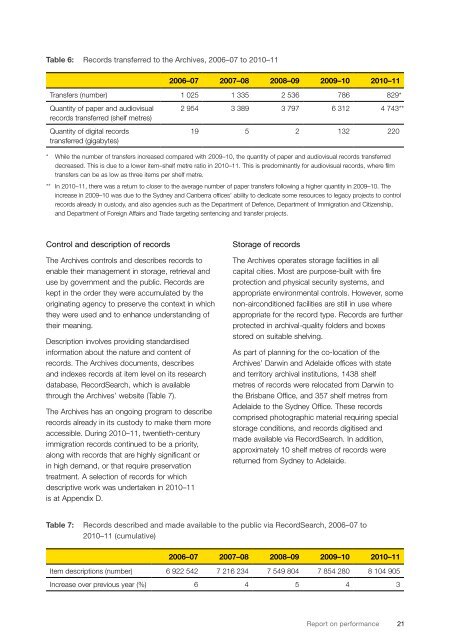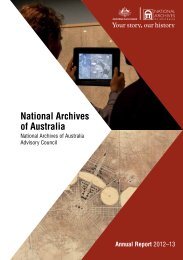National Archives of Australia - Annual reports
National Archives of Australia - Annual reports
National Archives of Australia - Annual reports
Create successful ePaper yourself
Turn your PDF publications into a flip-book with our unique Google optimized e-Paper software.
Table 6: Records transferred to the <strong>Archives</strong>, 2006–07 to 2010–112006–07 2007–08 2008–09 2009–10 2010–11Transfers (number) 1 025 1 335 2 536 786 829*Quantity <strong>of</strong> paper and audiovisualrecords transferred (shelf metres)Quantity <strong>of</strong> digital recordstransferred (gigabytes)2 954 3 389 3 797 6 312 4 743**19 5 2 132 220* While the number <strong>of</strong> transfers increased compared with 2009–10, the quantity <strong>of</strong> paper and audiovisual records transferreddecreased. This is due to a lower item–shelf metre ratio in 2010–11. This is predominantly for audiovisual records, where filmtransfers can be as low as three items per shelf metre.** In 2010–11, there was a return to closer to the average number <strong>of</strong> paper transfers following a higher quantity in 2009–10. Theincrease in 2009–10 was due to the Sydney and Canberra <strong>of</strong>fices’ ability to dedicate some resources to legacy projects to controlrecords already in custody, and also agencies such as the Department <strong>of</strong> Defence, Department <strong>of</strong> Immigration and Citizenship,and Department <strong>of</strong> Foreign Affairs and Trade targeting sentencing and transfer projects.Control and description <strong>of</strong> recordsThe <strong>Archives</strong> controls and describes records toenable their management in storage, retrieval anduse by government and the public. Records arekept in the order they were accumulated by theoriginating agency to preserve the context in whichthey were used and to enhance understanding <strong>of</strong>their meaning.Description involves providing standardisedinformation about the nature and content <strong>of</strong>records. The <strong>Archives</strong> documents, describesand indexes records at item level on its researchdatabase, RecordSearch, which is availablethrough the <strong>Archives</strong>’ website (Table 7).The <strong>Archives</strong> has an ongoing program to describerecords already in its custody to make them moreaccessible. During 2010–11, twentieth-centuryimmigration records continued to be a priority,along with records that are highly significant orin high demand, or that require preservationtreatment. A selection <strong>of</strong> records for whichdescriptive work was undertaken in 2010–11is at Appendix D.Storage <strong>of</strong> recordsThe <strong>Archives</strong> operates storage facilities in allcapital cities. Most are purpose-built with fireprotection and physical security systems, andappropriate environmental controls. However, somenon-airconditioned facilities are still in use whereappropriate for the record type. Records are furtherprotected in archival-quality folders and boxesstored on suitable shelving.As part <strong>of</strong> planning for the co-location <strong>of</strong> the<strong>Archives</strong>’ Darwin and Adelaide <strong>of</strong>fices with stateand territory archival institutions, 1438 shelfmetres <strong>of</strong> records were relocated from Darwin tothe Brisbane Office, and 357 shelf metres fromAdelaide to the Sydney Office. These recordscomprised photographic material requiring specialstorage conditions, and records digitised andmade available via RecordSearch. In addition,approximately 10 shelf metres <strong>of</strong> records werereturned from Sydney to Adelaide.Table 7:Records described and made available to the public via RecordSearch, 2006–07 to2010–11 (cumulative)2006–07 2007–08 2008–09 2009–10 2010–11Item descriptions (number) 6 922 542 7 216 234 7 549 804 7 854 280 8 104 905Increase over previous year (%) 6 4 5 4 3Report on performance 21



